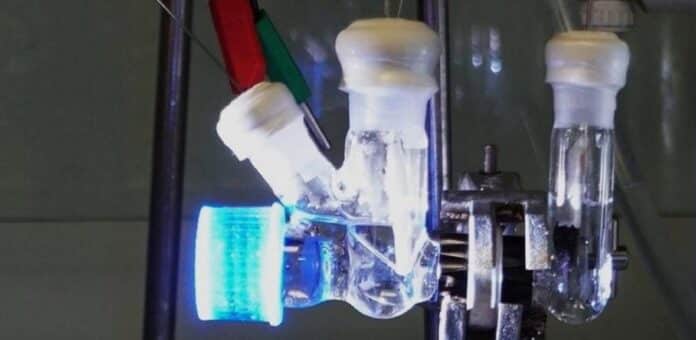Mitigating anthropogenic CO2 accumulation is essential for addressing climate change and biodiversity loss. Global efforts are underway to develop CO2 conversion technology for green fuel production on a large scale.
Researchers have shown how carbon dioxide from industrial operations or even straight from the air can be gathered and converted into clean, sustainable fuels using only solar energy.
The University of Cambridge researchers created a solar-powered reactor that transforms collected CO2 and plastic waste into sustainable fuels and other useful chemical compounds.
Researchers working under the direction of Professor Erwin Reisner have been creating carbon-neutral, sustainable fuels modeled after the photosynthesis process that turns sunlight into food. The scientists captured and concentrated CO2 and turned it into sustainable fuel using real-world sources like industrial exhaust or ambient air.
The solar-powered technique permits the selective extraction of CO2 from industrial processes or the air. It operates with flue gas or directly from the air. It is a significant technical problem to make this technology selective enough to convert significantly diluted CO2.
The scientists modified their solar-powered system to work with flue gas or directly from the air. They converted CO2 and polymers into fuel and chemicals only using solar energy.
The device uses an alkaline solution to bubble out other airborne gases while selectively trapping CO2, making it easier to work with.
The integrated system includes a photocathode and an anode with two compartments: one for captured CO2 solution turned into syngas, a simple fuel, and the other for valuable chemicals converted using sunshine.
The plastic component is critical to this system since it contributes electrons to CO2 and degrades into glycolic acid, widely used in cosmetics.
The team is developing a bench-top demonstrator system with increased efficiency and practicality to demonstrate the advantages of combining direct air capture with CO2 utilization as a road to a zero-carbon future.
Reisner said, “We’re not just interested in decarbonization, but de-fossilization – we need to completely eliminate fossil fuels in order to create a truly circular economy; in the medium term, this technology could help reduce carbon emissions by capturing them from industry and turning them into something useful, but ultimately, we need to cut fossil fuels out of the equation entirely and capture CO2 from the air.”
The researchers were inspired by carbon capture and storage (CCS), which involves capturing CO2 and pumping and storing it underground.
He said, “CCS is a technology that’s popular with the fossil fuel industry as a way to reduce carbon emissions while continuing oil and gas exploration, But if instead of carbon capture and storage, we had carbon capture and utilization, we could make something useful from CO2 instead of burying it underground, with unknown long-term consequences, and eliminate the use of fossil fuels.”
The researchers modified their solar-powered device to convert CO2 and polymers into fuel and chemicals using just solar energy, and it now operates with flue gas or directly from the air.
The CO2 is trapped when air is bubbled through a system containing an alkaline solution, while the nitrogen and oxygen that are also present in the air harmlessly bubble out. The researchers can concentrate the CO2 from the air in the solution using this bubbling method, making it more manageable.
An anode and a photocathode are both parts of the integrated system. In the first of the system’s two compartments, trapped CO2 solution is transformed into syngas, a straightforward fuel. On the other hand, using simply sunlight, plastics are transformed into valuable compounds.
Co-first author Dr. Motiar Rahaman said, “The plastic component is an important trick to this system; capturing and using CO2 from the air makes the chemistry more difficult. But, if we add plastic waste to the system, the plastic donates electrons to the CO2. The plastic breaks down to glycolic acid, widely used in the cosmetics industry, and the CO2 is converted into syngas, a simple fuel.”
Co-first author Dr. Sayan Kar said, “This solar-powered system takes two harmful waste products – plastic and carbon emissions – and converts them into something truly useful.”
Rahaman said, “Instead of storing CO2 underground, like in CCS, we can capture it from the air and make clean fuel from it; this way, we can cut out the fossil fuel industry from the process of fuel production, which can hopefully help us avoid climate destruction.”
The researcher said, “The fact that we can effectively take CO2 from the air and make something useful from it is special. It’s satisfying to see that we can do it using only sunlight.”
The Winton Programme for the Physics of Sustainability, the European Commission Marie Skodowska-Curie Fellowship, the Weizmann Institute of Science, and the Engineering and Physical Sciences Research Council (EPSRC), a division of UK Research and Innovation (UKRI), all provided funding for the study.
The Cambridge Circular Plastics Centre (CirPlas) combines innovative ideas with doable solutions to eradicate plastic waste.
The results show that it marks another significant step towards creating clean fuels to power the economy without harmful oil and gas extraction.
Journal Reference:
- Motiar Rahaman,Sayan Kar,etal.Integrated capture and solar-driven utilization of CO2 from flue gas and air. Joule. DOI:10.1016/j.joule.2023.05.022
